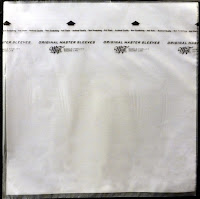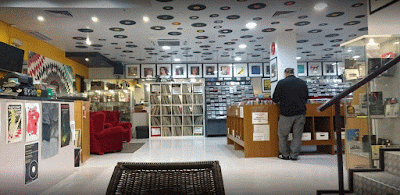 |
| Capitol 78 corporate sleeves |
 |
| My 1959 NM original mono copy of Time Out in its original glassine dust sleeve |
 In the modern LP era, the vast majority of dust sleeves are made from paper or some type of polypropylene. In the 50s and 60s, some labels used thin, clingy, half-round plastic sleeves. I have a number of Columbia (and other) issues with those. A lot of Japanese issues also used these half-round plastic sleeves. They are notoriously hard to get in and out of the jacket. You end up putting the bottom in first, leaving the open part of the sleeve at the opening of the jacket, which kind of defeats the purpose of using a dust sleeve to keep dirt and dust off the LP. [You do store all your albums with the opening of the dust sleeve at the top of the jacket, right? Right?]
In the modern LP era, the vast majority of dust sleeves are made from paper or some type of polypropylene. In the 50s and 60s, some labels used thin, clingy, half-round plastic sleeves. I have a number of Columbia (and other) issues with those. A lot of Japanese issues also used these half-round plastic sleeves. They are notoriously hard to get in and out of the jacket. You end up putting the bottom in first, leaving the open part of the sleeve at the opening of the jacket, which kind of defeats the purpose of using a dust sleeve to keep dirt and dust off the LP. [You do store all your albums with the opening of the dust sleeve at the top of the jacket, right? Right?]The dust sleeve at left is from a 1950s Capitol release. Since most people were used to dealing with 78s, Capitol felt the need to explain what "This Protective Envelope" is for, noting that it "keeps your record dust-free and helps guard the grooves against scratches and abrasion." They also helpfully provide tips for how to insert the sleeve back in the jacket.
 |
| MoFi dust sleeve |
There are any number of available after-market
 |
| Sleeve City 2 Mil poly sleeve |
 While I don't use them to store my records, I really enjoy looking at the original corporate and promo dust sleeves. They are often a miniature time capsule from an earlier era, with insight not just about the music of the day, but fashion and hair styles, marketing techniques, the latest hi-fi equipment, social issues, and even the cost of living. As an example, notice that the RCA sleeve at left offers to send you a copy of their complete catalog if you send them a quarter. And below is an ad introducing "The Exciting New Way to Enjoy the Music You Want," called, at the time, "RCA Stereo 8 Cartridge Tape," better know as the 8-track tape.
While I don't use them to store my records, I really enjoy looking at the original corporate and promo dust sleeves. They are often a miniature time capsule from an earlier era, with insight not just about the music of the day, but fashion and hair styles, marketing techniques, the latest hi-fi equipment, social issues, and even the cost of living. As an example, notice that the RCA sleeve at left offers to send you a copy of their complete catalog if you send them a quarter. And below is an ad introducing "The Exciting New Way to Enjoy the Music You Want," called, at the time, "RCA Stereo 8 Cartridge Tape," better know as the 8-track tape. 
Dust sleeves can also provide valuable clues for dating a particular pressing or release of an LP. If your LP is an undated repressing, you can sometimes narrow things down by checking the release date of the albums advertised on the dust sleeve. If you think you might have a first pressing, be sure that the dust sleeve doesn't advertise any albums that were released after the original pressing date. If so, then you probably don't have a first pressing. In addition, some albums have a custom insert - maybe a lyric sleeve or poster -- that was not included with later pressings. However, keep in mind that if you are buying used albums, you can't discount the possibility that the previous owner put the disk in the wrong sleeve. On a recent online order I received, about half the LPs were in corporate sleeves that didn't match the label.
 Because so many used LPs come with the
Because so many used LPs come with the wrong dust sleeve, I have dozens and dozens of extras. I save them, and from time to time am able to match up an album with the original sleeve, even for releases that are 30 or 40 years old.
While I always prefer to have the original inner sleeve, it's not a big factor to me when I'm shopping for used vinyl. When shopping online, you generally won't know anyway, since dealers rarely mention the sleeve in the item description unless it's unusual or damaged. The exception would be for custom dust sleeves, posters, or other inserts -- like the cutouts from Sgt. Peppers. And even then, if the vinyl is in prime condition, I figure sooner or later I'll find a cheap copy with a trashed LP but a jacket and inserts in good condition.
Dust sleeves are just one more reason why I find collecting LPs such an interesting hobby. Enjoy the music!










































